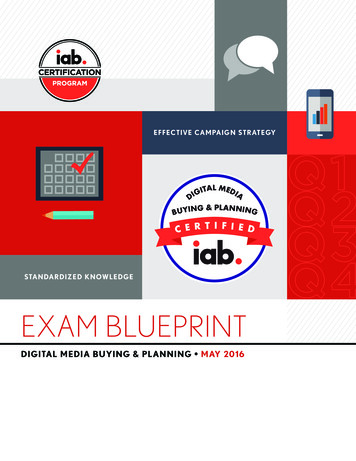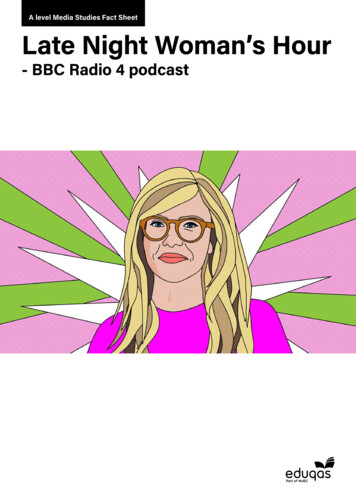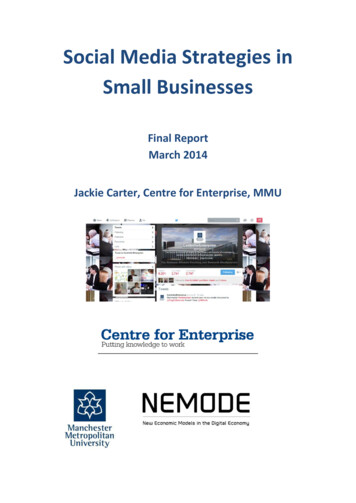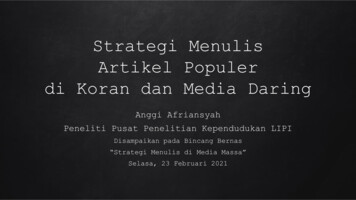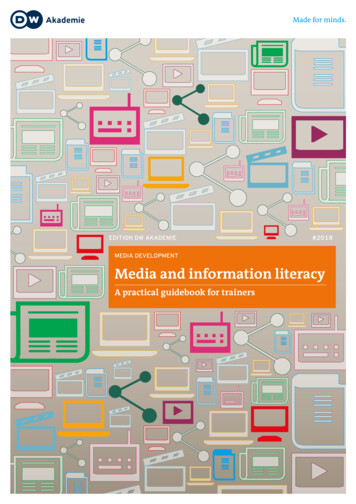
Transcription
EDITION DW AKADEMIE#2018MEDIA DEVELOPMENTMedia and information literacyA practical guidebook for trainers
ImprintPUBLISHERAUTHORSPUBLISHEDPHOTO CREDITSDeutsche Welle53110 BonnGermanySylvia BraeselThorsten KargJanuary 2018Second editionEDITING DW Akademie102, 103, 104, 105, 107, 146, 148: Sylvia Braesel 69, 108:Thorsten Karg 106: John R. Daily, https://en.wikipedia.org/wiki/Composition (visual arts)#/media/File:Rule ofthirds photo.jpg 107: fir0002 flagstaffotos.com.au, https://en.wikipedia.org/wiki/Composition (visual arts)#/media/File:Jonquil flowers at f5.jpg 109, 110: Screenshot Pixlr bySylvia Braesel 155, 156: Screenshot Viva Video by Sylvia Braesel 157, 158, 159, 160, 161: Screenshot Kinemaster by SylviaBraesel 188: Screenshot Facebook by Sylvia Braesel 205:photo Sylvia Braesel Thomas Podhostnik; photo ThorstenKarg Vytautas VaičeliūnasRESPONSIBLEChristian GramschHelen GroumasHeidi Walsh
EDITION DW AKADEMIE #2018MEDIA DEVELOPMENTMedia and information literacyA practical guidebook for trainersSylvia Braesel, Thorsten KargEdition DW Akademie Media and information literacy: A practical guidebook for trainers3
01ForewordKapitel4
Media and information literacy for today’s connected worldDW Akademie promotes Media and Information Literacy (MIL) projects in many parts of the world, including Burundi, Cambodia, Moldova, Namibia, Rwanda, Tunisia, Uganda, and the Palestinian Territories. In allof these countries and regions, our aim is to help people exercise their right to freedom of expression andtheir right to access information freely. In addition, our MIL projects increase awareness for how media workand how individuals can make their voices heard in public discussion and forums. To reach these goals, wework with youth and adults, teaching professionals, NGOs, and government ministries. The experience andknowledge gained in these projects all over the world have shaped and enriched this collection of materials.We would like to thank everyone who has helped in this process.In its original sense, the word literacy means knowing howto read and write. But in the 21st century, literacy has come tomean more than that. It encompasses media and informationliteracy as well. Today, it is essential to know how to use allmedia forms to make sense of our fast-changing world. Printmedia, radio and television, the Internet and other digitalcommunication technologies are decisive tools for findingrelevant information and joining in public discourse.Communication technology is developing rapidly throughout the world. Digital connections are improving and deviceslike smartphones are getting more powerful, affordable andeasier to use by the day. All this opens up vast opportunitiesfor people to communicate, engage in global conversations,and make their voices heard—even in developing societies.But in order to obtain access to this global wealth of information and participate actively in the conversation, peopleneed knowledge and skills. They need to know how and whereto find reliable information and how to communicate safelyand freely. They need to be media literate. This involves knowing where to find relevant information, how media shapepopular culture and opinion and influence personal choices,and how to navigate the Internet and ensure personal privacyin the cyber world. This guidebook can provide effective toolsfor use in these areas. The materials are primarily directedat trainers who work with youth. But anyone interested inmedia-related topics can use it as a source of information andfood for thought.Every topic is broken down into easy-to-follow lessonswhich have a participatory approach to teaching. The lessonsgive students a chance to learn about media through practicalexercises, discussions and games rather than through lectures.Educators may follow the suggested teaching plans or select and adapt individual elements that they consider suitablefor their students. There are lessons on how traditional mediawork (newspapers, radio and television), how informationbecomes news, and how to tell if information in the mediais biased or balanced and trustworthy. Other chapters givepractical tips on how people can tell their own stories throughsocial media such as Facebook. This will enable participants tomake their voices heard and raise awareness for issues that arerelevant to them.The texts and training tools collected in this guidebookwere produced by DW Akademie, Germany’s leading media development organization and part of Germany's internationalbroadcaster Deutsche Welle.Both Deutsche Welle and DW Akademie promote freedomof expression and access to information. Our fundamentalbelief is that this right can only be realized when all people areable to freely, independently, and confidently communicateonline, and not just offline. We would like to thank the GermanMinistry for Economic Cooperation and Development (BMZ)for funding our media and information literacy activities.Ute SchaefferHead of Media DevelopmentDW AkademieEdition DW Akademie Media and information literacy: A practical guidebook for trainers5
How to use this guidebookMedia and information literacy has become an essential skillfor people all over the world. Yet people aren’t born medialiterate—MIL needs to be learned and trained. If you are aneducator planning to teach media and information literacy,this book offers you a wealth of basic knowledge about mediaand a variety of training ideas.The core of this book was written to accompany a DWAkademie media and information literacy project in Cambodia. The idea behind that project was to teach a group of youngCambodian trainers the basics of media and information literacy and help them develop their training skills. They wouldthen, in turn, pass their newly gained media knowledge andskills on to youths in their rural home provinces.This guidebook was meant to give these young trainers background information, and supply them with trainingideas, methods and worksheets. The combination of factualknowledge about the fundamentals of media and informationliteracy and practical training tools like exercises, energizersand teaching aids, defines the structure of the guidebook youare reading now.Even though the booklet was originally intended for mediaand information literacy trainers in Asia, its scope has expanded significantly since we first started putting it together yearsago. DW Akademie meanwhile runs media and informationliteracy projects in many different countries. They range fromBurundi, Namibia and Uganda in Africa, to Moldova in Eastern Europe and to the Palestine Territories—and, of course,Cambodia in South-East Asia. Ideas and lessons learned inall of these projects have influenced and helped develop thisguidebook.As the geographic scope of DW Akademie’s media andinformation literacy projects has widened over the years, thetarget audience for this guidebook has become more diverse.We hope that educators will find this book helpful when theyteach media-related topics. Youths can also use it to explorethe world of traditional and social media and of photo andvideo messages all by themselves. In addition, the book mayeven be a tool NGOs can use to better understand how journalists and media work.If you are an educator, this guidebook provides you witha wealth of suggested teaching plans. These proposed agendas also contain information about how long each trainingsegment will take, what the learning objectives are and whatmaterials you will need.The book includes various topics, such as basic information about media, news and journalism, social media, photography and video. There is no prescribed order of which topicto start with, or which exercise to do first. You don’t have tometiculously work through each of the chapters, energizersand exercises, either. Think of this guidebook as a restaurantmenu: you can pick what you like, try it, then choose something else. And it’s perfectly all right to start at the end of thisguidebook and explore other parts later. As an educator, you6know your target group best. Feel free to adapt the methodsand level of difficulty according to your trainees’ prior knowledge, skills, and training needs.You can download the worksheets and guidelines for eachchapter to print and distribute to your trainees rainersEducators will see that much of the learning takes place ina fun and playful way. Learning should be enjoyable, otherwisetrainees will not be motivated. We hope that those teachingmedia and information literacy will empower their trainees tobe curious and ask questions. Tapping into the trainees’ priorknowledge and creativity will increase their motivation tolearn more and raise their self-esteem.As the authors of this guidebook, we hope you will find itrelevant, fun and useful. Please send us your feedback. We’d behappy to hear your suggestions or questions.Sylvia Braesel, Thorsten Karg
ForewordTerms and phrases used in this guidebookAs you read this guidebook, you will repeatedly encountersome key terms and categories of material: Certificate Incentive for trainees after completing a trainingsegment. An example can be seen in Part 3 “Social Media andWeb 2.0”. Trainers can use this example or create differentcertificates for their own purposes.Energizers There are energizers at the beginning of eachchapter of this guidebook. They are directly connected tothe content of the respective chapter, and will introducetrainees to the individual topics in a playful way. After playing these energizers, trainers should make sure the traineessee the connection between the game and the media-relatedtopic of that chapter.Essentials Learning objectives that provide an indication ofwhat trainees should know or be able to do at the end of atraining segment, and a proposed training schedule. xercise Practical application of knowledge. Exercises helpEtrainees practice skills and process or test their newly-gainedknowledge. Guidelines Tips and instructions for trainers teaching thistopic or conducting the proposed exercises. Trainers can alsodownload and print or photocopy them as hand-outs for thetrainees.Introduction Initial part of the proposed training schedule foreach chapter. Designed to familiarize trainees with key termsand issues of the chapter.Output Creation of a media-related product, such as an interview, photo story or presentation. An output at the endof a training segment helps trainees summarize the newlylearned skills and knowledge and draw conclusions for everyday life.Worksheets Handouts, questionnaires and forms trainers candownload and print or photocopy to distribute to trainees.Worksheets help trainees explore topics, practice skills andbuild new knowledge.Edition DW Akademie Media and information literacy: A practical guidebook for trainers7
ContentsImprintForewordHow to use this guidebookTerms and phrases used in this guidebook2467Introduction to media and information literacy (MIL)What is media and information literacy?Group energizers1011141. Media and information literacy16What are media?Understanding mediaLearning objectivesScheduleMediaMedia biographyMy media biographyDefining mediaOnline research: MediaOne event — different storiesOne event — different storiesMedia and me and youMedia and me and you172022222324252627282930312. Information and topics32What is information?What is a topic?Learning objectivesScheduleInformation and topicsWord of mouthWord of mouth (blank)Word of mouthUp to date? Information sourcesWeighing informationWeighing information: Quality criteriaChannels of information 1 — government press Channels of information 2— private press (commercial)Channels of information 3 — news agenciesChannels of information 4 — independent pressChannels of information 5 — social media, Web 2.0 Channels of information 6— talking to people (firsthand)Preparing a press conferenceWall newspaper: HeadlinesCreating a collageEditorial meeting and newsNews and categoriesNews: Brief, initial inquiryBroadcast 53565758Research and news writingPresenting my topic59603. Power of pictures62What is the power of pictures?63Your photosLearning objectivesScheduleYour photosEye of the photographerEye of the photographerPhotos — beginners to professionals“Beginners”: Composition rules I – photos“Beginners”: Digital editing I – photos“Professionals”: Composition rules II — photos“Professionals”: Digital editing II — photosPhotos as storytellersDeveloping a photo storyPreparing your photo storyStoryline and storyboardPhotographers’ mLearning objectivesSchedulePhotojournalismPower of picturesImpact of pictures: InterviewPictures: Impressions and emotionsCharacteristics and ethics of photojournalismCharacteristics of photographsCC photos for the WebCC photos for the WebPower of pictures — beautyImpact of pictures — beauty IImpact of pictures — beauty IIBecome a photojournalistPreparing your slideshowOpinions come alive in photosDigital editing basicsComposition rules IComposition rules IIDigital editing: Pixlr Express (cell 1094. Audio112What is audio?Learning objectivesScheduleAudioIntroduction to radio content113116116117118
Radio quizOn air! The newsOn air! Test recordingAudio recordingChecklist: Our radio newsThe interviewThe interview planVox pop — radio useVox pop1191201221231241251271281305. Video132What is video?Learning objectivesScheduleVideoVideo briefingVideo profile of Vlogging — setting an agendaVlogging — plan and prepareAction! Video sequencingQuiz: Video shot sizesFive-shot ruleStoryboardRole-playing: YouTube starCheck it! YouTube videoPresent it! YouTube channelEditing video: VivaVideo (cell phone)Editing video: KineMaster (cell 41551576. Social media and Web 2.0162What are “social media” and “Web 2.0”?163Internet safety and privacyLearning objectivesScheduleSocial mediaExperiencesGame — post scrambleFacebook — private or public?Station A Profile check: Private picturesStation B Profile check: Shared contentStation C Profile check: “About”Station D Profile check: DynamicsFacebook expertFacebook expertFacebook expertWeb 2.0: My opinion on Storyboard — Web 2.0: My opinion on ke news and information bubblesWhat is fake news? What are information bubbles?181182Learning objectivesScheduleThe information bubbleMy Facebook news feed #1My Facebook news feed #2The information bubbleFake or fact? Debunking fake storiesQuiz on fake newsFact or fake?Debunking fake newsTalk show: Consequences of fake newsTalk show: Scenario and rolesModerating the talk iseGuidelinesIntroductionOutputWorksheetEdition DW Akademie Media and information literacy: A practical guidebook for trainers9
Introduction tomedia and information literacy(MIL)10
What is media and information literacy?“Literacy” is the ability to read and write. “Media and information literacy” is the ability to fully use many types of media.Media and information literacy is a set of skills that enable aperson to access media, analyze media content, create newmedia messages, reflect on existing media content, and takeaction with media. Media literate individuals are better ableto understand complex messages from newspapers, magazines, books, radio, television, billboards, video games, music, the Internet, social media, and all other forms of media,as well as produce media messages themselves.In many countries, media and information literacy has become part of school curricula. Educators have discovered thatmedia and information literacy is essential and an effective andengaging way to apply critical thinking skills to a wide range oftopics. Because media technologies develop rapidly and mediasystems are complex and ever-changing, media and information literacy has become an essential skill all over the world.Why is media and information literacy important?Understanding media and their influence on society and individuals is a necessary skill for everybody. The skills learned forbecoming media literate help raise people’s awareness for theirMedia and information literacy can help people:Develop critical thinking skillsUnderstand how media messages shape our culture andsocietyIdentify targeted marketing strategiesRecognize what the media maker wants us to believe or doculture, their values, and the significance of information andcommunication. Media systems, societies, and individual human beings are complex and multi-faceted. That’s why medialiterate people should avoid making quick, simplistic judgments.One objective of media and information literacy is creatinggreater access to media and increasing participation in mediacreation. This can give rise to new visions for media access,structure, and control, and develop societies where people arevalued as citizens and not treated as subjects.Thanks to new media technologies, people can nowanalyze and create texts and messages in a wide variety ofestablished and new media. But the skills needed to createand analyze media have to be learned, trained and continuously updated. As a result, media and information literacyalso means lifelong learning.Young people in particular need opportunities to engage with educators in making sense of their variety of experiences with mass media, interpersonal media and mediatechnologies.What steps can trainers take to promote media and information literacy?There are a number of approaches trainers can take to training media and information literacy skills. They are, of course,free to vary the suggested curriculum and develop their ownindividual teaching methods. Trainers should remain aware oftheir objectives and how these objectives can be reached. Theyshould also remember to reflect on their teaching after eachtraining session. Additionally, it is important for trainers to beaware of their own personal media habits and how these couldinfluence their teaching.Trainers are encouraged to follow five steps when helpingstudents develop their media and information literacy skills:access, analyze, create, reflect, and take action.Media and information literacy 1 — accessName the techniques of persuasion usedAvocate for changes to the media systemRecognize bias, spin, misinformation, and liesDiscover the parts of the story that are not being toldEvaluate media messages based on our own experiences,skills, beliefs, and valuesCreate and distribute our own media messagesSource: medialiteracyproject.orgAccess is the first step in media and information literacy andaddresses learning how to find and comprehend media messages, and how to use media technology. In this step, peoplelearn about finding and sharing appropriate and relevantinformation.When children learn to read, for example, they learn howto hold a book and turn the pages. They notice the meaningof the words formed by letters and learn to understand therelationship between words and pictures. Decoding and understanding the meaning of printed words is an importantaccess skill.This example of learning how to access a text or a book canbe transferred to all types of media. Access is always mediaspecific: it takes different skills to use different media. To findinformation online, for instance, you have to be skilled in usingEdition DW Akademie Media and information literacy: A practical guidebook for trainers11
technology. You have to know what keywords are appropriateto type into search engines and know how to navigate throughthe suggested online sources. Participation in social networksrequires the ability to interact socially despite being alonephysically, to decide what content should be shared and, often,multitasking skills.No one has the skill to master appropriate access to allkinds of media types and media content. It is impossible tobe an expert at using all technology tools and dealing withall kinds of content. The objective, then, is to know how toimprove access to online tools, information and software, inorder to make sense of media and be capable of using information. This is not a skill that can be learned in one day; itrequires time and life-long learning. But if someone has developed proficiency in accessing contemporary media, it isunlikely they will have problems gaining access to new formsand types of media.Media and information literacy 2 — analyzeBeing able to analyze information is the second step in mediaand information literacy. Someone skilled at analysis is capableof interpreting and evaluating various forms of print and nonprint messages, such as images, written texts, news, videos,films, video games, the Internet, and social media. Studentshave to be trained to develop strategies for interpreting, evaluating, and analyzing print media, like books and newspapers;visual media, like video and photography; audio media, likeradio and music; and digital media, like video games, websitesand social media.People with analytical skills know that the author, purposeand point of view of the media and message have to be considered in order to understand what assumptions messagesare built upon and how they are constructed. Students haveto learn how important it is to also consider a message’s targetaudience, quality, authenticity, credibility, and its potential effects or consequences.Learning to ask good questions to promote critical thinking is a target of media analysis and a skill that can be trained.Another goal is to reflect on the social, political, historical,economic, and cultural context of media messages. For example, it can be useful to ask questions about the institutionsinvolved in media production and the role audiences play increating meaning from media messages. Asking good, openquestions stimulates analysis and evaluation skills. Studentsgenerally need to gain knowledge and improve their terminology to train their analytical skills. The more students know, thebetter and deeper their questions will be, which in turn leadsto new information and discoveries.Training analytical skills also requires the ability on thepart of the teacher to ask good questions and hold back his orher own views and values. Analysis and evaluation are essential for students when it comes to understanding media mes-12sages ‘from the inside’ and stepping ‘outside’ to take a morecritical look at media and messages.Media and information literacy 3 — createCreation is the third step in media and information literacy.Students are asked to create their own messages based ontheir access to certain media types and their analytical skills.This is necessary for becoming part of a media system that includes media production and digital tools, and for expressingideas using collaborative learning experiences.Creating media messages used to involve just pencil and paper. Nowadays, students can learn to create and compose texts,sounds, music, videos, radio shows, podcasts, digital journals,pictures, blogs, websites, cartoons, and computer games. Theirexpression can take multiple modes, they can use differentgenres, including narrative, persuasive, and expository forms,and use images, language, sound, graphic design, performanceand interactivity to send a message. Students need to becomeable to express their ideas and creativity, and to digitally sharewhat they have created with others via the Internet. Studentsshould be able to compose meaningful messages for real audiences. Sharing self-generated content also helps boost theirconfidence in self-expression.It is important to note that creation and composition areincreasingly collaborative processes. Teams can work togetherto conceptualize, rehearse, perform, and edit their productions. This means people with a range of varying talents andabilities need to be able to work together.Media and information literacy 4 — reflectReflection is the fourth step in media and information literacyand builds on access, analysis and creation skills. Improvingthis skill requires sophisticated thought and consideration ofeveryday media experience, and knowledge about media. Itis essential to think about the impact of media messages andtechnology on the individual and his or her personal daily activities, as well as their impact upon society.There’s no doubt that personal media habits and online activities affect people’s identity, self-esteem, relationships, andfuture. It is important that educators understand how to fosterstudents’ ethical, social, and emotional development.This is why it is essential to draw a connection betweenstudents’ media and information literacy skills and their media and communication behavior, and to promote social andemotional skills that help students develop a sense of socialresponsibility and ethical principles. To strengthen media andinformation literacy, students should reflect on how they constantly make choices about how to use media, how to interactsocially, and how values are conveyed via media messages.Students should also train their awareness of how media andmedia technology affect people’s attitudes and behaviors.
IntroductionStudents should be encouraged to see things from various perspectives, to try to imagine the thoughts, feelings, and ideas ofothers, and to practice empathy.For example, the instant and fleeting nature of digital media may encourage impulsive behavior. Students can reflect ontheir personal habits and experiences by examining social media and texting. This creates an awareness of their own socialmedia behavior and that of their peers. Students can examinehow social status, hierarchy, respect and power are exercisedthrough communication practices, including praise, criticism,rumor and gossip. They can try to predict the possible consequences of their work and use hypothetical reasoning to talkabout power and responsibility.Additional topics for discussions on media ethics includeprivacy, copyright, fair use, attribution, and new forms of sharing.Media and information literacy 5 — actTaking action is the fifth and final step in media and information literacy and is based on all the previously trained skills.The concept of taking action is included in media andinformation literacy education because it is essential that students’ empowerment goes beyond the classroom and has animpact on society. Ideally, teaching should connect the classroom to relevant local, national or global social and politicalissues. As important members of society, students can maketheir voices heard on a larger scale and thus improve the quality of life in their families, homes, schools, communities andthe world.Taking action can include working both individually andwith others. The objectives of active media work are to shareknowledge, and to address and draw attention to relevant issues facing the communities, countries and the world. Thereis a relationship between education and social responsibility,and it’s important that people learn to develop integrity andaccountability for their actions.Edition DW Akademie Media and information literacy: A practical guidebook for trainers13
ENERGIZERSGroup energizersThese fun energizers will help trainees relax, laugh andhave fun in-between serious training modules. Trainers canchoose to play any of them whenever trainees get tired ordistracted.ICEBREAKER“Have you ever?”This game is an active, fun group activity for exploring andcelebrating the diversity of people’s past experiences. It workswell with large groups. Ask trainees to stand or sit in a circle.Start by explaining that you will ask various questions that mayor may not apply to each person. If what you say applies to aperson, then that person runs into the middle, jumps in the air,and gives a “high 5” to someone else who has also run in. Example questions: “Have you ever sung karaoke?” “Do you havea brother or a sister?” If a question is too personal or the answermight embarrass someone, the trainees can “block” the question by making a “stop” sign with their hands.ICEBREAKER RESPONSIBILITY“Line up!”“Line up” gives trainees a chance to organize without someoneelse being in charge. The members of the group line up or forma circle according to, for example, height, age, birth date, alphabetical order of names, number of brothers and sisters, etc.EMPATHY“Feelings in a hat”This game fosters interpersonal empathy. Ask trainees to writedown personal feelings (fears, wishes, dreams) anonymously onslips of paper that you then collect and mix in a hat. Each traineethen randomly selects and reads someone else’s feeling to thegroup and responds to it, talking about whether he or she understands the feeling, and offers a suggestion or adds an idea.BELONGING“Clapping in a circle”This is an activity that encourages trainees to listen, respondand work together. Ask trainees to form a circle, standing withtheir feet slightly apart and hands out in front. Explain that youare going to clap your hands and the group needs to repeat theexact same number of claps in the same rhythm. Start by clapping once, making sure to open your arms first so trainees seethe clap coming. Trainees mirror your clap. Repeat a few times,adding claps to create a series to be repeated. Then name atrainee to act as the leader, who repeats the process, and so on.Clapping in a sequence and following various leaders gives thegroup a sense of togetherness and belonging.14
IntroductionIDENTIFICATIONCOOL DOWN“Copy me”In this game, you use a combination of clapping and othersounds to make a pattern trainees then mimic. You can startwith a simple pattern of just 2 or 3 sounds or claps and then extend it. Speeding up the pattern makes it even more challenging for trainees to keep up and remember all the parts. A
Edition DW Akademie Media and information literacy: A practical guidebook for trainers 7 Foreword Terms and phrases used in this guidebook As you read this guidebook, you will repeatedly encounter





